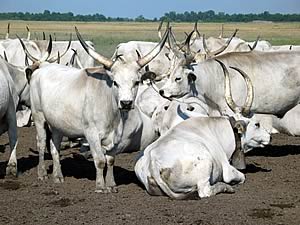 |
|||||||||
|
|||||||||||||||||||
Farm
animal diversity under threat The rapid spread of large-scale industrial livestock production focussed on a narrow range of breeds is the biggest threat to the world’s farm animal diversity, according to a report presented this week to the Commission on Genetic Resources for Food and Agriculture.
Surging global demand for meat, milk and eggs has led to heavy reliance on high-output animals intensively bred to supply uniform products, according to The State of the World’s Animal Genetic Resources for Food and Agriculture. The problem is compounded by the ease with which genetic material can now be moved around the world, says the report, which draws on information from 169 countries. “In the next 40 years, the world’s population will rise from today’s 6.2 billion to 9 billion, with all the growth occurring in the developing countries,” said FAO Assistant Director-General Alexander Müller in his address to the Commission. “We need to increase the resilience of our food supply, by maintaining and deploying the widest possible portfolio of genetic resources, which are vital and irreplaceable.” “Global warming is an additional threat to all genetic resources, increasing the pressure on biodiversity,” Müller adds. “Yet we need these genetic resources for the adaptation of agriculture to climate change.”
Time is running out “One livestock breed a month has become extinct over the past seven years, and time is running out for one-fifth of the world’s breeds of cattle, goats, pigs, horses and poultry,” says Müller. “This report, the first-ever global overview of livestock biodiversity and of the capacity within countries to manage their animal genetic resources, is a wake-up call to the world.” And this may only be a partial picture of the genetic erosion taking place, according to the report, as breed inventories are inadequate in many parts of the world. Moreover, among many of the most widely used high-output breeds of cattle, within-breed genetic diversity is being undermined by the use of a few highly popular sires for breeding. “Effective management of animal genetic diversity is essential to global food security, sustainable development and the livelihoods of millions of people,” says Irene Hoffmann, Chief of FAO's Animal Production Service. “While sometimes less productive, many breeds at risk of extinction have unique characteristics, such as disease resistance or tolerance to climatic extremes, which future generations may need to draw on to cope with challenges such as climate change, emerging animal diseases and rising demand for specific livestock products,” Hoffmann adds.
Some breeds are more equal Well-adapted livestock have been an essential element of agricultural production systems for more than 10 000 years, especially important in harsh environments where crop farming is difficult or impossible. Since the mid-twentieth century, a few high-performance breeds, usually of European descent – including Holstein-Friesian (by far the most widespread breed, reported in at least 128 countries and in all regions of the world) and Jersey cattle; Large White, Duroc and Landrace pigs; Saanen goats; and Rhode Island Red and Leghorn chickens – have spread throughout the world, often crowding out traditional breeds. This progressive narrowing of genetic diversity is largely complete in Europe and North America and is now occurring in many developing countries, which have so far retained a large number of their indigenous breeds.
Hotspot of breed diversity loss The developing world will be the hotspot of breed diversity loss in the twenty-first century, according to the report. In Viet Nam, for example, the percentage of indigenous sows declined from 72 percent of the total population in 1994 to only 26 percent in 2002. Of its 14 local breeds, five breeds are vulnerable, two in a critical state and three are facing extinction. In Kenya, introduction of the Dorper sheep has caused the almost complete disappearance of pure-bred Red Maasai sheep.
Conservation programmes lacking The crowding out of local breeds is set to accelerate in many developing countries, unless special provisions are made for their sustainable use and conservation by providing livestock keepers with adequate support, the report warns. Effective management of animal genetic diversity requires resources – including well-trained personnel and adequate technical facilities – which many developing countries lack. According to the report, 48 percent of the world’s countries report no national in vivo conservation programmes, and 63 percent report that they have no in vitro programmes, that is, the conservation of embryos, semen or other genetic material, with the potential to reconstitute live animals at a later date. Similarly, in many countries, structured breeding programmes are absent or ineffective. “Support for developing countries and countries with economies in transition to characterize, conserve and utilize their livestock breeds will be necessary,” says Clive Stannard of the Commission on Genetic Resources for Food and Agriculture. “Frameworks for wide access to animal genetic resources, and for equitable sharing of the benefits derived from them, need to be put in place, both at national and international levels.”
Protecting our common heritage At this week’s meeting of FAO’s Commission on Genetic Resources – the only international institution dealing with all genetic resources in agriculture, forestry and fisheries – experts from around the world are expected to endorse the findings of the report, which will be formally launched at the International Technical Conference on Animal Genetic Resources in Interlaken, Switzerland, in September 2007. The Interlaken conference is expected to adopt a global plan of action to halt the loss of animal genetic resources and improve their sustainable use, development and conservation.
|
|||||||||||||||||||

|
|
||||||||||||||||||
| home | agri-services | pedigree
pen | news | dairy | beef | machinery property | organisations | site map |
|||||||||||||||||||

